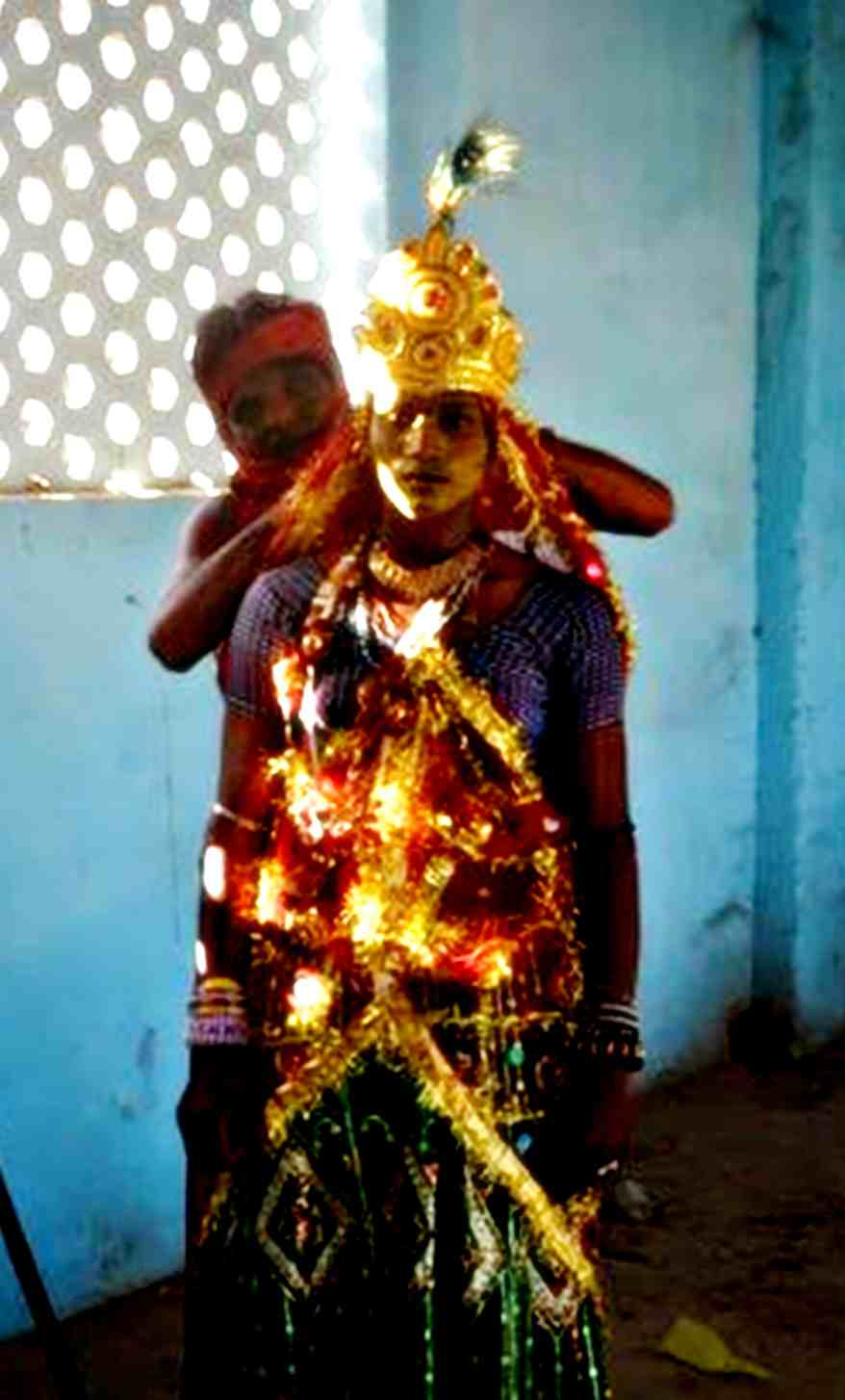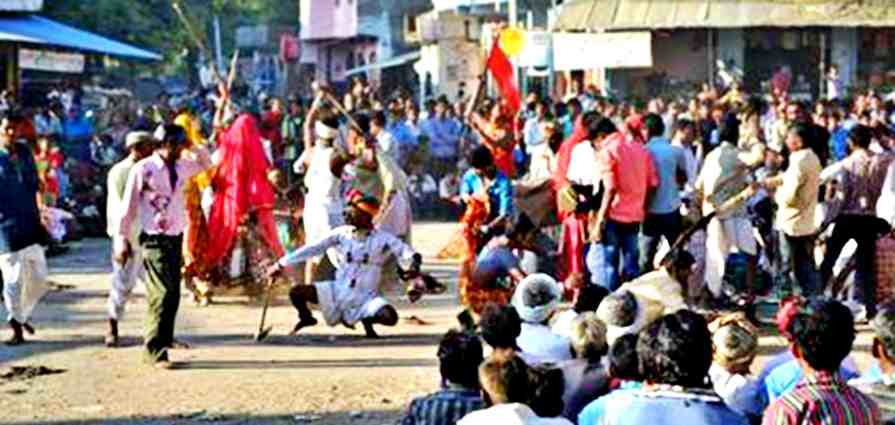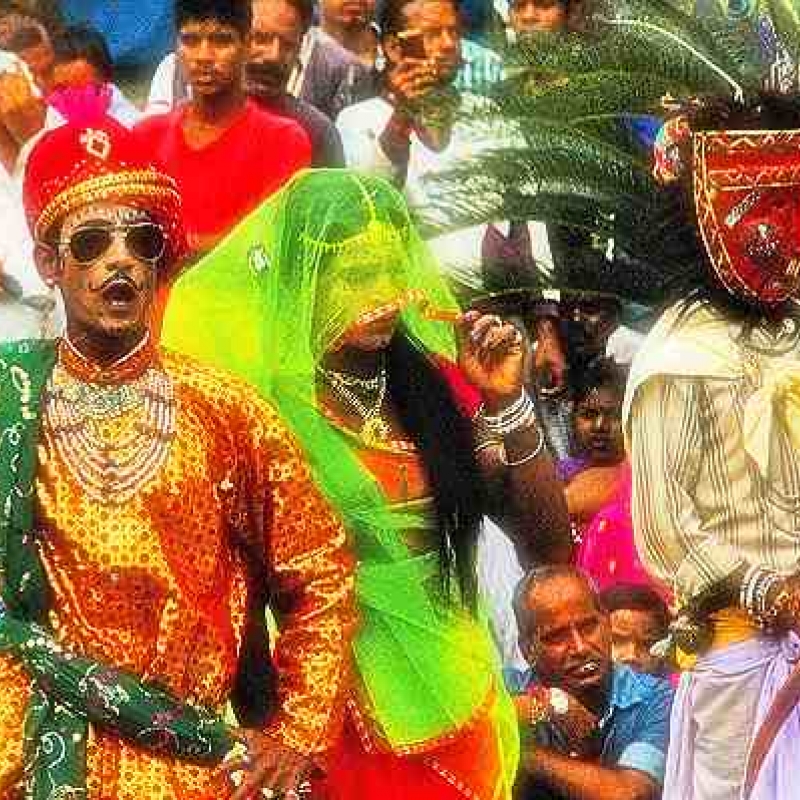For 40 days in the year, an entire village in Rajasthan’s Mewar region loses itself in the celebrations of the mother goddess, Gavari. We train the spotlight in this unique festival in which all members of the local Bhil tribe come together to perform a mystical dance and music drama like none other. (In pic: Actors dressed as various characters in a play during the Gavari Festival; Photo courtesy: Wikimedia Commons)
Each year a bhopa (priest) from the villages dominated by the Bhil tribe in Rajasthan invokes the goddess Gauri/Gavari/Ambavi mata ahead of the Hindu month of Shravan (around September). The one who is possessed by her energy, signals that their village has been chosen for the annual Gavari festival that year.
This selection, which happens every four–five years for every village, is a matter of great honour not only for that bhopa but also all members of the village. They have been chosen by the divine mother to celebrate her grace, the feminine energy and nature’s bounty over 40-days of festivities and abstinence.
It is a centuries-old tradition unique to the Mewar region of present-day Rajasthan, wherein the entire village comes together in ‘a spectacle of art, trance and ecstasy unlike any other in the world[1]’, says filmmaker Stephen Kries in his 2019 short film on the mystical dance drama. Performance of Gavari is usually held in Bhil villages. However, breaking the confines of the region, a Gavari presentation was made in Delhi in 2016 to introduce this fascinating culture to the rest of the country for the first time.[2] The Darohar Dance Evening at Udaipur’s Bagore ki Haveli is another platform for Gavari artistes, where they perform a snippet for tourists.
Also read | Origin of the Tiatr
A unique aspect of celebrations is that all members of the chosen village—not just the troupe—must abstain from worldly vices such as eating meat, drinking alcohol and sex for all the 40 days. They also avoid shoes, beds and bathing, and sometimes even stop eating greens as it might harm insects—all to deepen their connection with mother earth. Renowned scholar Kapila Vatsyayan says, such spiritual faculties and imbibing of non-corporeal characteristics helps in easing psychological problems and diseases.[3]
Women are not allowed to perform. They can only be spectators to the performances due to their menstrual cycle, says Harish Agneya in Gavari – Mewar's Electrifying Tribal Dance-drama.[4] So, the men dress as women to portray the goddess and other female characters. Such is their involvement in the performance, it’s not unusual to see men preparing days in advance by sprucing up their wardrobe with special costumes (with divine symbolisms), masks, bangles, bindis and jewellery. Amba Lal, a young boy in the Haraniya Kheda village, gets into character by putting on mehndi, lining his forehead with bindis and painting his nails. It’s not uncommon to see men in bangles around the village.

Invoking the Divine
The festival is initiated with the bhopas invoking the divine and going into a trance. Alongside, there are sacrifices and prayers. An idol of the goddess is placed at a central/public space (like a school or Panchayat Bhavan) and is consecrated. While she is worshipped here, the whole village erupts in festivities as each member is a participant in their own way. The most important of all is the troupe of actors and bhopas.
Also read | Adishakti: An Avant-Garde Language of Theatre
They invoke the goddess and are collectively possessed by Gavari mata’s energy every day. This is a necessity for the day’s events to begin. A typical day in the festival is illustrated with 10–15 hours of performance staged by the community members and attended by the entire village.

Stories of Gavari Mata
The subjects of these elaborate plays are a combination of folklore, mythology, history and some that are modernised to include current socio-political issues. However, the underlying theme is constant—Gavari mata will resolve all your troubles. Pray to her, believe in her and you will be happy.
The performers of Gavari hold many identities—they script, direct and perform it. Play-acting is merged with song and dance. While the stories have been passed over generations as oral knowledge, performers are free to contemporise it. It’s not uncommon to find a principal plot being interpreted differently by each village. Even the performances are extempore, with an invocation of the goddess by the bhopa, ‘creating’ a sacred energy that’s maintained by the troupe all through the 40 days of performance. The audience responds to this spiritual energy, which gives Gavari plays a ritualistic aspect that is distinct from other folk forms.
The storyline has a fixed beginning and end, wherein it’s usually a victory of good over evil. For instance, Goma Chor is a popular Gavari narrative, where Goma—a young Bhil boy—steals money, plunders the temple and robs the community during drought. Gavari mata punishes the boy because in difficult times the community has to stick together. This play is followed by a song sung along with the audience. In Garulia Lohar, the troubled blacksmith asks all the gods for help, but it is only Gavari mata who provides a solution.
These oral stories often become a source for reinforcing community knowledge- communal harmony, togetherness, recalling historical wars and heroes. [5]They provide a foundation to establish the Bhil identity by collectively recalling the oral tales of the tribe.
The play is usually performed in a common space in middle of the village, where the audience is constituted from all castes sitting in divided caste lines. Often dialogues include audience interaction and then finally a trance-like dance involving many.
Interestingly, of late, these stories of Gavari have been included in local Hindi schoolbooks and curricula, in an attempt to connect students with their culture.


Folk Theatre and Cross-Dressing
Another interesting aspect of Gavari how the men in the community cross-dress en mass. Men taking on female roles is common across Asia. In Japan, there’s the 17th-century Kabuki theatre. India, Nautanki (Maharashtra) and Gotipua (Odisha) are well known. But makes Gavari unique is that the assumption of a female persona is not restricted to just the actors, but also other villagers. Cross-dressing is considered as a means of connecting with the divine mother.
However, some scholars such as Samuel L. Leiter argue that the cross-dressing is more a result of patriarchal values than a ritual[6]—as women performing in public is considered a social taboo.[7]
The 40-day festival concludes with a crescendo of drums, bells and chants that creates a wave of energy that is transferred to the audience by the performers and bhopas. The period of abstinence is ended with a celebratory consumption of the local liquor (mahua) and non-vegetarian food. During this period, the Bhils forget their every-day struggles, surrendering themselves to the compassionate and powerful goddess Gavari as she lives within them, with the belief that she will always protect them.
As the bhopas and performers return to their regular lives, this belief lives on in them, as does the anticipation of the next cycle of Gavari.
This content has been created as part of a project partnered with Royal Rajasthan Foundation, the social impact arm of Rajasthan Royals, to document the cultural heritage of the state of Rajasthan.
This article was also published on South Asia Monitor.
Notes
[1] Stephan Kries, The Bhil Tribe of Rajasthan - Gavari Theatre Ritual (film). Accessed March 17, 2021. https://stephankries.com/bhil/.
[2] ‘Going global: Mewar's Tribal Folk Opera “Gavri” Ready for International Stage’, The Times of India, Udaipur, August 19, 2016. Accessed March 14, 2021. http://timesofindia.indiatimes.com/city/udaipur/Going-global-Mewars-tribal-folk-opera-Gavri-ready-for-international-stage/articleshow/53908600.cms
[3] K. Vatsyayan, Traditional Indian Theatre: Multiple Streams (New Delhi: New Delhi National Book Trust, 1980).
[4] Harish Agneya, W. David Kubiak, et al., Gavari - Mewar's Electrifying Tribal Dance-drama: An Illustrated Introduction, Tuneer Films (First Edition, 2014). Accessed March 16, 2021.
https://en.wikipedia.org/wiki/Gavari#cite_note-:0-8.
[5] ‘Gavari: The Unwritten Epic of a Mewari Tribe’, 2017, ICHCAP, UNESCO. Accessed March 16, 2021
[6] Samuel L. Leiter, ‘From Gay to Gei: The Onnagata and the Creation of Kabuki's Female Characters’, Comparative Drama 33, no. 4 (1999), 495-514. Accessed March 7, 2021. http://www.jstor.org/stable/41154044
[7] Hansen, Kathryn. "Making Women Visible: Gender and Race Cross-Dressing in the Parsi Theatre." Theatre Journal 51, no. 2 (1999): 127-47. Accessed March 7, 2021. http://www.jstor.org/stable/25068647.













